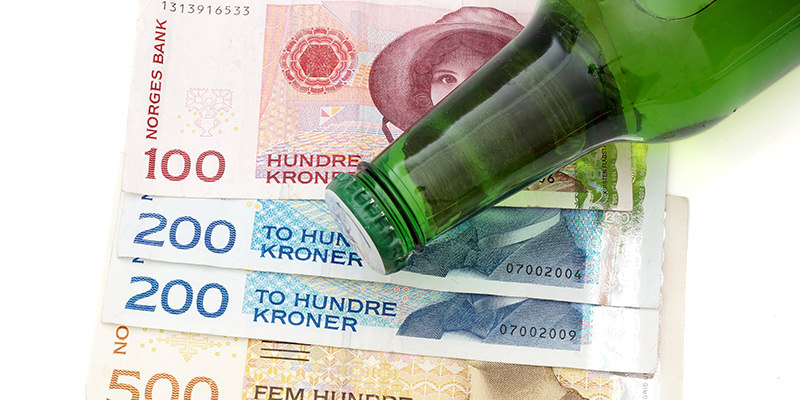Vinmonopolet might sound like some sort of refined, wine-related Monopoly game you play while wearing a monocle, but it’s actually the name of the government-controlled sale of alcohol in Norway (“wine monopoly,” they’re not resorting to euphemisms here). As it turns out, all Nordic countries—save Denmark—restrict alcohol sales with some combination of state control and/or high taxation. In Norway, the Vinmonopolet was founded to control the sale of any alcohol over 4.75% ABV, for the sake of the people. (Compare that to Oklahoma, where you can’t refrigerate any beer over 4% ABV. Liquor laws and good intentions can make for some strange restrictions.)
You’re already wondering—“Why a state-controlled wine monopoly? Norwegians seem so well behaved.” Well, back in the 19th century, things were a bit…saltier. According to the 1891 Cyclopaedia of Temperance and Prohibition, by 1833, there were 9,727 distilleries in Norway, “and the annual consumption of liquors was estimated at nearly 4 gallons per capita,” enough to inspire prohibitionist Asbjorn Kloster to rally for total ban on alcohol sales. It took for a time, as prohibition does, but Norway likes its drink. By 1923, prohibition was lifted, and the Vinmonopolet had taken over, mainly to maintain the traditions of national temperance while still allowing for alcohol sales. (It seems like this would be a very, very tough sell in the U.S., like if the federal government took over after Al Capone.)
Terrifying as state-controlled booze may sound, there’s a (sort of) silver lining: after the German Occupation left Norway in 1945, there were about 400,000 liters of Bordeaux left behind. The Vinmonopolet started selling it—nicknamed “Sekskroners,” or “six kroner” for its price (kind of like “Two Buck Chuck” for those Trader Joe fans out there)—and it was an enormous hit, rapidly establishing a foundation for Norwegian wine culture. In fact, it was too popular. The Vinmonopolet ran out of Bordeaux by 1947.
Cheaper wines were imported from places like Chile and Tunisia, but failed to sell, leaving the Vinmonopolet without its signature Bordeaux leg to stand on. Enter Haakon Svensson in 1949, tasked with creating a blend to keep the Sekskroners going—and keep Norwegians from drinking too much hard liquor (which they were drinking at the time at a rate of 10 to 1, hard liquor to wine). Svensson’s efforts were a success, and the Sekskroners “Rodvin” (made with anywhere from 5 to 10 wines) continued to be the Vinmonopolet’s top seller into the 1980s.
But as more wine became available in Norway—by now the Vinmonopolet does six annual launches of new products to supplement their usual stock, including Bordeaux in December, Champagne and Chablis in May, and U.S. Beer and Wine in October—Rodvin began to lose out. It’s sort of like the craft beer story: founders like Sam Adams and Sierra lose credibility or cachet and new blood moves in. In fact, as recently as August of 2014, Rodvin was basically voted off the shelves, to be replaced by a token “Folkets Originale Rodvin,” aka “The People’s Original Red Wine.”
 The Bordeaux story is weird, from the leftover 400,000 liters of Bordeaux to the blending efforts to replace it. But maybe the weirdest part of the Vinmonopolet is how well it goes over in Norway (with 88% consumer satisfaction in 2009). Originally sourcing and importing as well as selling wines, it was disallowed in 1996, when the European Free Trade Association ruled it a monopoly (it is in the name…). But the solution was pretty elegant: split off into private import company Arcus, and Vinmonopolet will continue to sell the imported wine on behalf of the well-behaved state. There are some good aspects to it: apparently, consumers pay a fraction (something like one third) of the market price. And the Vinmonopolet actually guarantees its wine, meaning you can return “faulty” wine anytime within five years (years) of purchase. Drawbacks? Well, there are heavy taxes, which go up with the ABV of the beverage. There’s the limited selection (and low price), which can make wine sales a bit less than civilized (imagine one of their six annual wine releases, plus Black Friday), and a privately chosen (as in not market-driven) wine selection—what wine critic Tom Marthinsen called “the taste bureaucracy.”
The Bordeaux story is weird, from the leftover 400,000 liters of Bordeaux to the blending efforts to replace it. But maybe the weirdest part of the Vinmonopolet is how well it goes over in Norway (with 88% consumer satisfaction in 2009). Originally sourcing and importing as well as selling wines, it was disallowed in 1996, when the European Free Trade Association ruled it a monopoly (it is in the name…). But the solution was pretty elegant: split off into private import company Arcus, and Vinmonopolet will continue to sell the imported wine on behalf of the well-behaved state. There are some good aspects to it: apparently, consumers pay a fraction (something like one third) of the market price. And the Vinmonopolet actually guarantees its wine, meaning you can return “faulty” wine anytime within five years (years) of purchase. Drawbacks? Well, there are heavy taxes, which go up with the ABV of the beverage. There’s the limited selection (and low price), which can make wine sales a bit less than civilized (imagine one of their six annual wine releases, plus Black Friday), and a privately chosen (as in not market-driven) wine selection—what wine critic Tom Marthinsen called “the taste bureaucracy.”
Norwegians may have moved past Bordeaux and Rodvin, but they’re still interested in their wine, and the Vinmonopolet, with a high satisfaction rate for the monopoly, especially since it became simply a retailer (and not importer, basically wine king of all) in 1996.
Again, not sure the concept would work in the U.S., but in Norway, monopoly seems to be an okay way to play the wine game.
